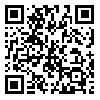BibTeX | RIS | EndNote | Medlars | ProCite | Reference Manager | RefWorks
Send citation to:
URL: http://ijpcp.iums.ac.ir/article-1-2355-en.html
2- Behavioral Sciences Research Center, Deportment of Psychiatry, School of Medicine, Isfahan University of Medical Sciences, Isfahan, Iran
3- Psychosomatic Research Center, Isfahan University of Medical Sciences, Isfahan, Iran
Objectives: Bipolar and unipolar depressions are different in terms of both biological or clinical sign and symptoms, so the available scales are not suitable for measuring the depression in bipolar disorder. The aim of the present study was to determine the psychometric features of the Persian Version of Bipolar Depression Rating Scale (BDRS). Method: A total of 368 participants, including 120 patients with bipolar disorder in the period of depression and 126 patients with major depressive disorder from the Medical Centers affiliated to Isfahan University of Medical Sciences, Iran, in the years of 2011-2012 and also 122 healthy individuals among relatives of patients and the staff of the sampling centers, were recruited in this study. Bipolar Depression Rating Scale (BDRS), Hamilton Depression Rating Scale (HAM-D), Young Mania Rating Scale (YMRS) and Beck Depression Inventory (BDI-II) were used for gathering the information. Data analysis was done by using of Pearson’s correlation coefficient, factorial analysis and discriminate analysis. Results: Bipolar Depression Rating Scale (BDRS) had high internal consistency in the population of Iran (&alpha=0.81) and its validity was confirmed by robust correlation with Beck Depression Inventory (BDI-II) (r=0.61) and Hamilton Depression Rating Scale (HAM-D) (r=0.71). Correlation of the mixed subscale of BDRS with Young Mania Rating Scale (YMRS) was 0.69. Factor analysis identified three factors of psychological, physical and mixed depression however, some of its items were different from original version. The most suitable clinical cutoff point was score of 18 with sensitivity and specificity of 93% and 94%, respectively. Conclusion: Persian version of the Bipolar Depression Rating Scale in Iranian population has provided the suitable and reliable psychometric features.
Received: 2015/09/29 | Accepted: 2015/09/29 | Published: 2015/09/29
| Rights and permissions | |
 |
This work is licensed under a Creative Commons Attribution-NonCommercial 4.0 International License. |



